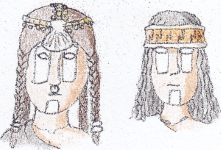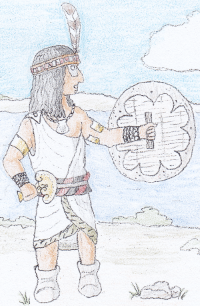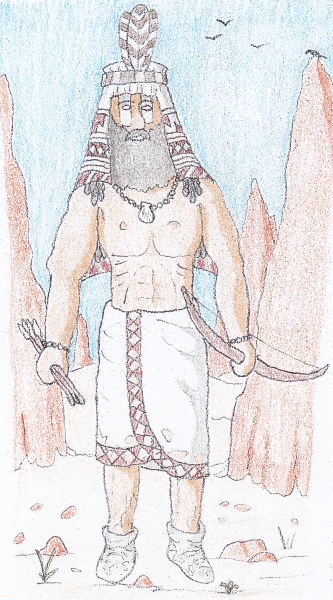Orrólans
Dalran: Orrólere
The orrólans1 inhabit the deserts and rocky coast of Orrs in northwestern Túlmikkía, variously subsisting on hunting, herding goats or fishing and agriculture depending on the region. Their position between the empire of Dalra to the northwest and kingdoms of Vagalkan to the east, as well as access to luxuries such as myrrh, salt and tobacco, means that their coastal cities thrive despite the harsh environment of their homeland.
Their main settlements are the coastal cities of Dind, Dlúm and Óaa.
Jewelry made of painted terracotta- stone or metal beads is popular, and shells are highly sought after by desert tribes due to their association with water. Face-paint in form of white vertical markings around eyes and chin are ubiquitous among orrólans.
Long, often braided hair or -more rarely- dreadlocks are common for men and women alike, and long beards are favoured by most men.
Other traditional food includes pumpkins, lentils, tepary beans, goat meat and dairy products, seaweed and wild game. Common dishes includes dates stuffed with soft goat cheese and lentils boiled in milk. The most popular beverages are palm wine, corn beer and fermented goat milk.
Ancestor worship is practiced to some extend, both among individuals and the tribes as a whole, the latter are closely associated with rituals to summon rains.
The orrólans1 inhabit the deserts and rocky coast of Orrs in northwestern Túlmikkía, variously subsisting on hunting, herding goats or fishing and agriculture depending on the region. Their position between the empire of Dalra to the northwest and kingdoms of Vagalkan to the east, as well as access to luxuries such as myrrh, salt and tobacco, means that their coastal cities thrive despite the harsh environment of their homeland.
Their main settlements are the coastal cities of Dind, Dlúm and Óaa.
Culture
Apparel
Orrólan clothing varies significantly between regions, with those living in the desert preferring simple wraparound loincloths or tunics, either made of animal skins or imported linen, while the people of Aam and especially in cities prefer elaborate cloaks and more complicated styles, often influenced by surrounding cultures. Geometric patterns or heavily stylized floral patterns are popular.Jewelry made of painted terracotta- stone or metal beads is popular, and shells are highly sought after by desert tribes due to their association with water. Face-paint in form of white vertical markings around eyes and chin are ubiquitous among orrólans.
Long, often braided hair or -more rarely- dreadlocks are common for men and women alike, and long beards are favoured by most men.
Art
Pottery
Orrólan pottery is highly sought after throughout Gætíus' World for its high quality and unusual abstract or highly stylized imagery painted on it.Cuisine
Maize is the staple crop of the orrólans, either grown on terraces irrigated with water from nearby streams, or by trapping moisture using a layer of gravel. White, orange and violet varieties are common. Date palms are the second most important crop, as not only do they produce dates, but sap for palm wine, edible flowers, young leaves and heart-of-palm, though the latter is only served for special occasions by the wealthy, as removing the terminal bud kills the plant. The seeds are also ground into flour and made into a kind of bread.Other traditional food includes pumpkins, lentils, tepary beans, goat meat and dairy products, seaweed and wild game. Common dishes includes dates stuffed with soft goat cheese and lentils boiled in milk. The most popular beverages are palm wine, corn beer and fermented goat milk.
Religion
Orrólan religious practices vary greatly between settled and nomadic tribes, the former worship a pantheon of deities, ancestral spirits and culture heroes, often in sacred caves with walls covered in geometric patterns and idols carved from stalactites, while the latter venerate few if any deities, but have a strong belief in fate and destiny.Major deities
Dilúk
Dilúk, also known as Dlek and Lú, is the main orrólan fertility god. In every flock is a goat sacred to Dilúk, marked with a single gold earring, which is believed to bring good fortune to the goatherds and are generally left alone.Jandaa
Jandaa (Indaa, Jant) is a culture hero venerated by all orrólans, who taught them agriculture and weaving before he mysteriously disappeared, at which point the land turned into a desert. Orrólans believe that one day Jandaa will return and make the land green again.Núl
Núl, also known as Njúl or Njú, is the main creator deity and god of the sun. Every rock and cliff which resembles a face is sacred to him.Tatá
Tatá is the goddess of fate, and is the main deity of the desert tribes. Her oracles give people prophesy by throwing seven sacred arrows into the air and examining the pattern they make on the ground.Haaná
Also known as Aná, Haaná is a goddess of healing and associated with salt. She's mother of the culture hero Jandaa in most traditions.Motá
Motá is the goddess of war, whose worship ceases entirely during the annual four month ceasefire each year, during which weapons are covered in cloth or furs, and anyone who brakes that rule is faced with immediate exile.Tamá
Tamá is the goddess of love.Vúdaa
Also known as Taa or Úv, Vúdaa is a protective deity depicted as a snake, sometimes with a human head. Nomads carry several statuettes of him made of bone, terracotta or metal, and place them by cave entrances or around their camp to keep evil spirits at bay. In cities, statues of Vúdaa are found by the main entrances of most homes.Funerary practices
Unlike their neighbours, there's little focus on the afterlife and fate of the soul in orrólan religion, as they generally focus more on the mortal world, particularly on upholding the laws and traditions within their tribes. The dead are usually buried in a cairn, which rarely includes offerings of food and drink as it would attract scavengers, while in Óaa the dead are placed in tombs inspired by dalran funerary pillars2.Ancestor worship is practiced to some extend, both among individuals and the tribes as a whole, the latter are closely associated with rituals to summon rains.
Warfare
The traditional weapon of the orrólans is a kind of dagger, usually made of bronze, with a wide giving it resemblance to a mirror. This weapon is similar to daggers used Enans and Ænateans. Other weapons are essentially the same as used for hunting, such as spears, javelins and bows.
Armour is minimal, usually little more than one or two metal armlets and a small, round shield made of wicker and leather.
Orrólan mercenaries have long been employed by Galkans, Dalrans, Akalúrans and other emlatine cultures.
Armour is minimal, usually little more than one or two metal armlets and a small, round shield made of wicker and leather.
Orrólan mercenaries have long been employed by Galkans, Dalrans, Akalúrans and other emlatine cultures.
Related Organizations
Languages spoken









Comments